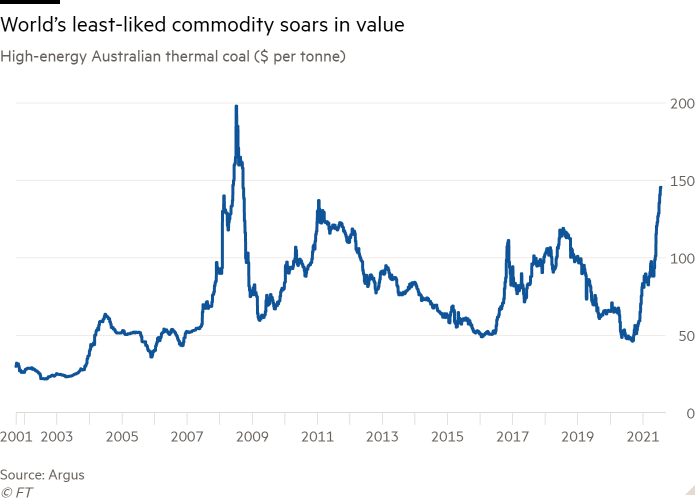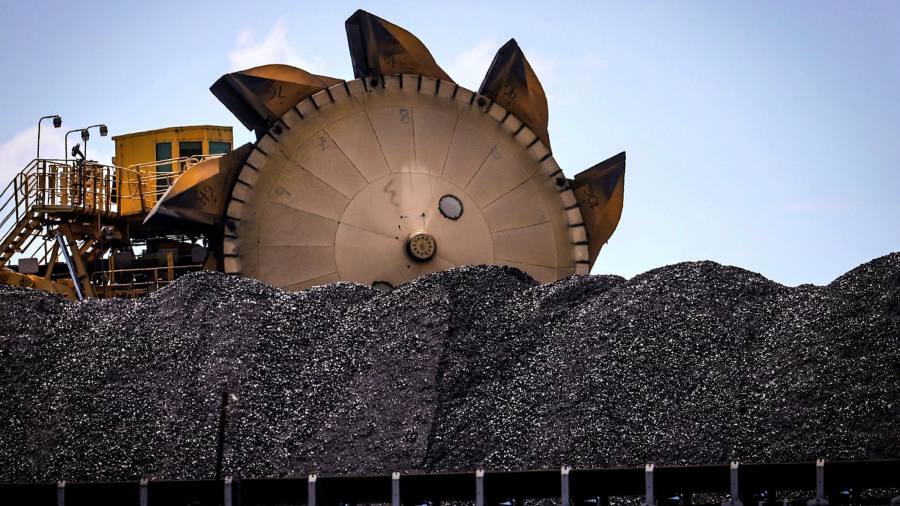Supply disruptions, a drought in China and rebounding electricity demand have fired up the market for thermal coal, making the world’s least liked commodity one of this year’s best-performing assets.
Since the start of the year, the price of high energy Australia coal — the benchmark for the vast Asian market — has climbed 80 per cent to almost $146 a tonne, its highest level in more than a decade.
Its South African equivalent is also trading at its highest level in more than 10 years, after rising 44 per cent in 2021 according to the latest weekly assessment by commodity price provider Argus.
That puts the coal benchmarks ahead of two of this year’s best performing asset classes: real estate, which is up 28 per cent, and financial stocks, up 25 per cent. Only Brent crude, up 44 per cent, boasts comparable gains.
The resurgence of thermal coal, which is burnt in power stations to generate electricity, highlights the difficulties governments face as they try to make the switch to cleaner forms of energy.
Even though renewables such as wind and solar are growing rapidly they are struggling to keep pace with rising demand for electricity and power, leaving fossil fuels to fill the gap.

Several factors linked have combined to drive up prices, according to traders and analysts.
“Price increases have been primarily driven by robust demand from China, with Chinese buyers willing to secure material at highest prices,” said Dmitry Popov, senior thermal coal analyst at CRU, a consultancy.
A drought earlier this year in southern China, which knocked out hydroelectric dams and boosted demand for coal, has played a major role in the commodity’s turbocharged run.
China has also struggled to boost domestic supply to meet the increased demand due tough safety rules that have crimped production volumes.
At the same time output from Indonesia, China’s biggest overseas supplier of coal, has been hampered by persistent rainfall, while rail and port constraints have affected shipments from Russia and South Africa, two other key coal producers.
China has also been unable to buy Australia coal because of a ban, while surging natural gas prices have prompted some utility companies in Japan and Europe to switch to coal, further tightening the market.
“I have never seen China under this sort of pressure before,” said Tom Price, head of commodities strategy at Liberum. “Hydro down, local production struggling and key import options just not there.”
All this has come as electricity demand has picked up as Covid-related lockdowns have eased.
After falling by around 1 per cent in 2020, global electricity demand is set to grow by close to 5 per cent in 2021, according to the International Energy Agency, and by 4 per cent in 2022.
“While renewable energy sources are expected to continue to grow rapidly, they will only be able to serve around half of the net demand increase in 2021 and 2022,” the IEA said in its latest Electricity Market Report.
As a result, the Paris-based agency reckons coal-fired electricity will increase by almost 5 per cent this year to exceed pre-pandemic levels and grow by a further 3 per cent in 2022 when it could reach a record high.
Still, not everyone believes high prices will hold. Fitch Solutions predicts prices will peak later this year as Beijing releases coal from its strategic stockpiles and orders miners to increase production. In additional fossil power generation in China typically peaks in July and August before falling sharply.
“Consequently, we continue to expect a slowdown in domestic thermal coal demand by the start of September,” said Popov.
Looking further ahead, the big question for thermal coal is whether environmental polices will result in demand weakening more quickly than supply, as bank and insurers refuse to fund new projects.
“I expect supply to fall faster than demand,” said Price at Liberum, who thinks China and India will continue to buy coal in the export market for the next decade. “It is a super tight market. It’s not going to crash in a heap.”
